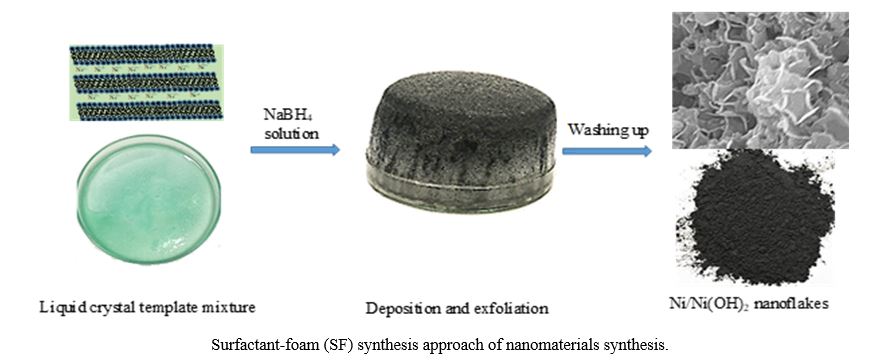Video Article Open Access
Surfactant-Foam Synthesis of Nanomaterials for Boosting the Electrochemical Energy and Sensors Reactions
Mohamed A. Ghanem*, Saba A. Aladeemy, Abdullah M. Al-Mayouf, Nouf H. Alotaibi, Mabrook S. Amer
Chemistry Department, College of Science, King Saud University, Riyadh 11451, Saudi Arabia
Vid. Proc. Adv. Mater., Volume 3, Article ID 2210362 (2022)
DOI: 10.5185/vpoam.2022.10362
Publication Date (Web): 27 Nov 2023
Copyright © IAAM
Graphical Abstract

Abstract
Engineering the electrocatalysts’ nanoarchitectures, particularly the transition metal compounds with nanometer size, shape, facets, and composition, significantly boosts the electrocatalytic activity of the electrochemical energy reactions [1,2]. This work demonstrates a novel chemical approach for the synthesis of mesoporous nanoarchitectures (nanoflakes, nanosheets) of transition metal (nickel, cobalt, copper) hydroxides using double templates of surfactant self-assembled thin-film and foam of hydrogen bubbles concurrently produced by sodium borohydride reducing agent. The physicochemical characterizations show the nanomaterials exhibit high specific surface area and mesoporosity, various nanoarchitecture morphologies (nanoflakes and nanosheets), and compositions that can be varied in a controllable way through changes in the template compositions and deposition conditions. The electrocatalytic activity and stability of the new transition metal nanomaterials have shown significantly enhanced performance for the electrochemical energy and sensing reactions of methanol, urea, glycerol, and glucose oxidation as well as the water-splitting reactions of hydrogen and oxygen evolution. The electroactivity high-performance of the mesoporous transition metals nanoarchitectures is mainly derived from the high specific surface area and mesoporosity architecture that provide efficient charge transfer, as well as mass transport of the electroactive species. The double templates of the surfactant-foam (DTSF) approach have the advantages of a one-pot template applicable to the synthesis wide range of nanomaterials with various compositions and nanoarchitectures at room temperature for application in electrochemical energy production and storage [1,2].
Keywords
Double template; mesoporous; nanomaterial; sensors, electrochemical energy reactions.
Acknowledgement
This project was funded by the National Plan for Science, Technology, and Innovation (MAARIFAH), King Abdulaziz City for Science and Technology (KACST), Kingdom of Saudi Arabia, Award Number 13-NAN-1309-02.
References
- M.A. Ghanem, et. al, Nanomaterials, 2022, 12(5), 879; Arabian J. Chem. 2022,15, 103467; J. Electroanal. Chem. 2020, 871, 114268; Nanomaterials, 2019, 9, 1502; J. Electrochem. Soc., 2018, 165, H300.
- M.A. Ghanem, et. al, US Patent US20200333283A1, 2020.
Biography
Mohamed A. Ghanem obtained his PhD in Chemistry in 2002 from the University of Southampton (UK) in the field of synthesis, characterizations, and applications of nanostructured materials. He works as postdoctoral researcher at Southampton and Bath University (2003-2008). He joins King Saud University in 2012 as associate prof. of physical chemistry and promoted to full professor in 2017. His research interests focus on nanomaterials, fabrication, characterization, and applications for energy production and storage. He acts as editor for the Journal of Saudi chemical society and awarded the IAAM Medal in 2018 for notable and outstanding research in the field of New Age Energy Materials & Technology. He published about 110 papers, five patents and his i10-index is 70 with 3800 citations. I have been included in the list of top 2% Scientists of AD scientific index 2021-22 (energy).
Video Proceedings of Advanced Materials

Upcoming Congress



